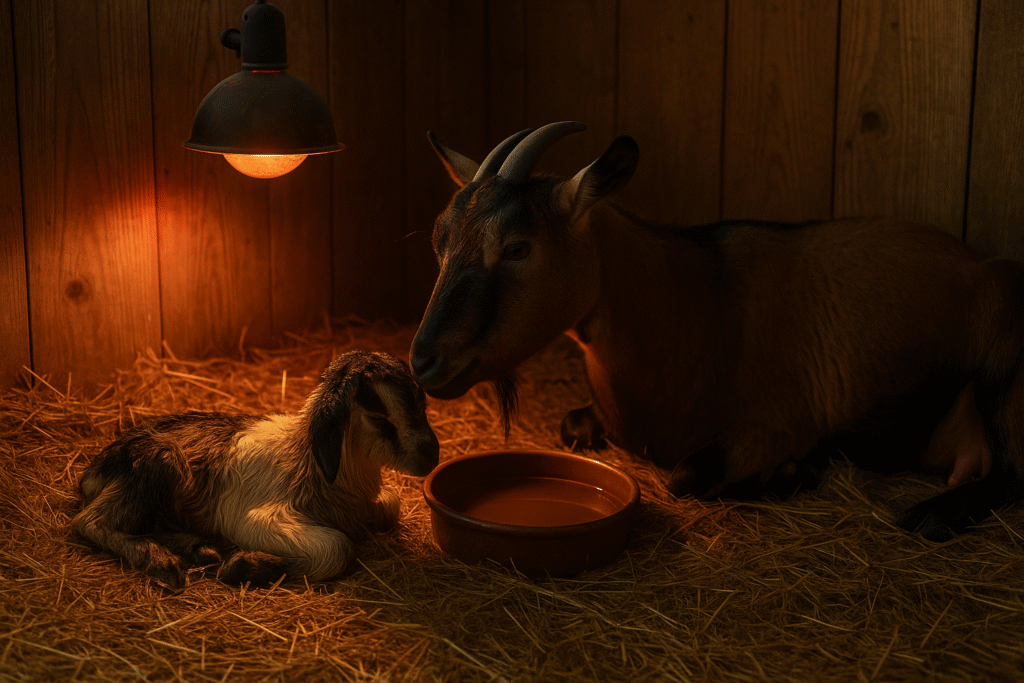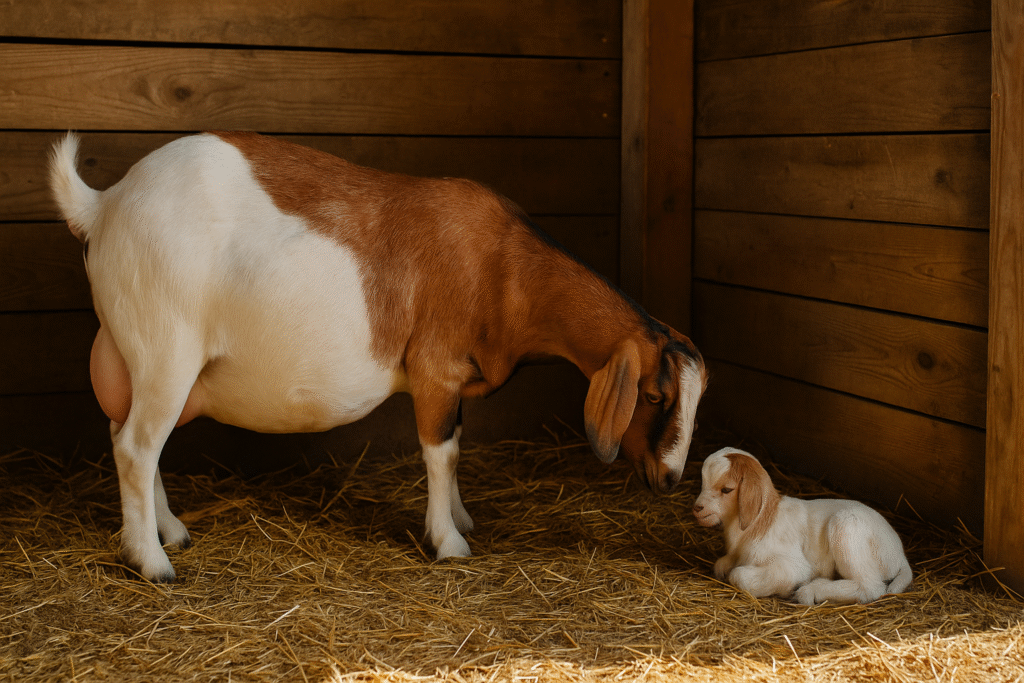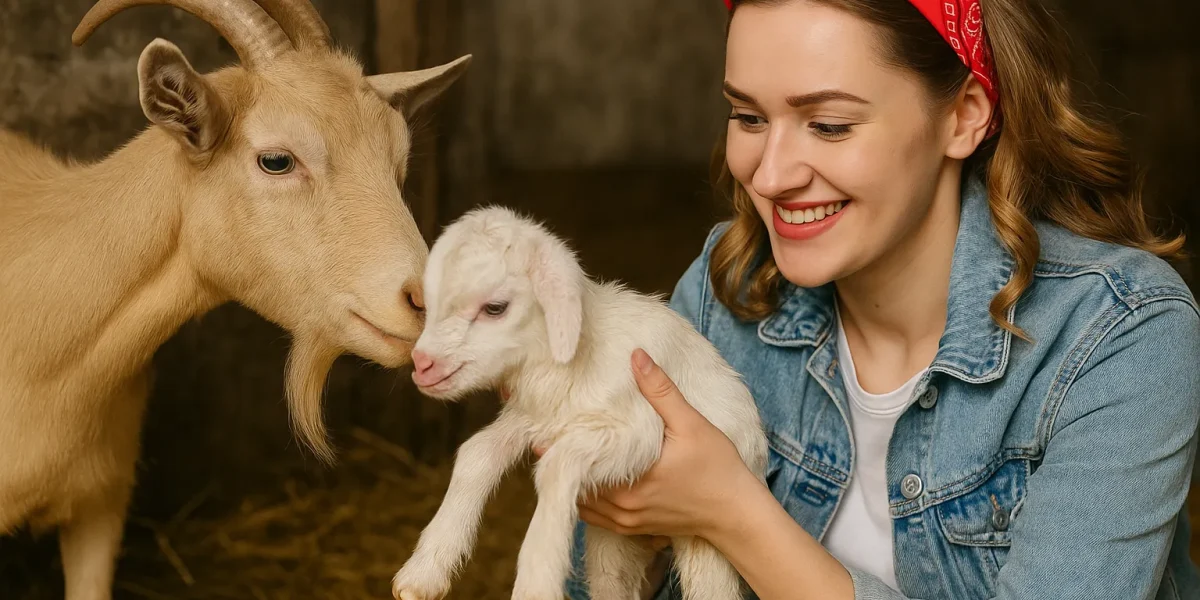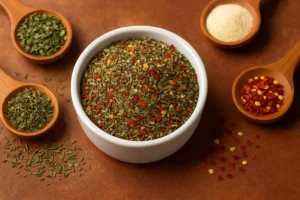I’ve been raising goats for five kidding seasons now, and if there’s one thing I keep coming back to, it’s the goat gestation period day by day. That 145-to-155-day stretch of waiting, watching, feeding, fretting… every moment counts. If you know your gestation period well, you can plan, you can be calm, and you can avoid being woken up in the middle of the night panicking that something’s wrong. In this post, I’m sharing everything I’ve learned: from how to tell when a goat is in labor, what actually happens at goat kidding, recognizing signs your goat is close to giving birth when they matter most, handling goat triplets birth and care tips, and giving the best newborn goat care I can muster.

Goat Labor Signs
One thing I love about goats is how individual each one is—but goat labor signs tend to follow patterns, and once you’ve seen it a few times, you recognize them early. These are what I watch for in the last week, or last few days before kidding.
- The tail ligaments loosen and feel soft. I always wiggle that joint; when it gets floppy, I know we’re getting close.
- The doe starts acting restless: pacing, shifting her bedding, maybe pawing at corners or moving straw around.
- Her vulva swells noticeably. Sometimes you see clear or translucent mucus, or she loses the mucus plug.
- Udder starts filling. For first-time moms, this can happen later; for seasoned does, it’s more obvious earlier.
- Behavioral changes: seeking solitude, being quieter or more moody, maybe off feed at odd times.
When I start seeing some of these, I double my check-ins. Putting on a little extra bedding, preparing a goat kidding stall, and gathering warm towels. Because once these early signs of goat labor show, action comes fast.
Goat Kidding
How to assist a goat during kidding is something you only truly learn through experience. Even though every goat is different, there are things you can prepare so that kidding goes smoother (for you and the doe!).
I always move the doe to the kidding stall a day or so before she’s due (or showing strong labor signs). Having her accustomed to the stall means less stress when contractions start.
My kidding stall is clean, dry, well-bedded (straw + shavings), safe from drafts, and has easy access to clean water. Also, good lighting helps when the action starts at night.
I have what to include in a goat birthing kit ready: clean towels, iodine, gloves, a bulb syringe, scissors (sterilized), and a flashlight. I might not need to use all of it, but I want it there.
Warmth is huge. If it’s cold, I use a safe heat lamp or extra blankets—keeping newborn goats warm in cold weather is essential, since newborn kids chill quickly.
That rush after birth, the first mom-kid bonding, watching kids find teats—it’s worth every bit of preparation.

Signs of Goat Labor
Sometimes “goat labor signs” and how to tell if a goat is about to kid sound like the same thing—and they are—but I break them into early vs. active, because you need to know when to move from “this might happen soon” to “this is it.”
Early signs (24–72 hours before kidding):
- Doe becomes restless, maybe off feed a little.
- She may isolate from the herd or separate herself.
- Tail up more often, sniffing or licking bedding, pawing.
- Udder and teats enlarge.
- Pin bones start softening.
Active signs (real labor):
- Visible contractions, especially in her sides and abdomen.
- A water sac or membrane appears (sometimes it breaks on its own).
- You see two front hooves and a nose—best scenario. If the kid is poorly positioned, I get ready to assist.
- The pushing becomes more frequent and intense.
If goat labor usually lasts longer than 30–45 minutes with no kid coming, that’s when I call my vet or a goat-birthing mentor to check things out.
Triplets
Triplets are both excitement and extra work. I’ve had a few does with triplets, and they’ve stretched my goat-mom skills more than once. Here’s what I’ve noted from my experience with goat triplets birth and care tips:
- Does with triplets often show gestation signs earlier and sometimes deliver a little sooner than single or twin pregnancies.
- The births may come more quickly once labor starts, but I’ve also seen more tangling—kids coming too close together, or one kid’s presentation messing with another. So I stay close, gloves on, just in case.
- After birth, it’s extra important to make sure all kids get goat colostrum feeding. Sometimes one is weaker or slower, and needs help. I keep an eye out for body warmth and strength.
Newborn Goat Care

Okay, the kidding is done, the kids are here. This is my favorite part—and probably the part where calm prep makes the biggest difference. Here’s my caring for newborn goat kids after birth routine.
Immediately Clear Airways and Dry Off
Right after birth, I make sure their nose and mouth are clear of fluids. Then dry them off with towels. Chilly newborns are at risk, especially in cool or damp weather.
Umbilical Cord Care
I dip the navel in iodine to prevent infection.
Ensure Colostrum Feeding
Within the first 1–2 hours, the kids should be up and nursing or bottle-fed colostrum. That first milk is life—antibodies, warmth, and energy. One of the kids might miss the teat, so I help if needed. I follow a goat colostrum feeding guide for newborns to make sure each kid gets enough.
Keep Them Warm and Safe
I make sure the stall is draft-free. If needed, I add a heat lamp or extra bedding. I check that there are no places kids might get stuck or injured.
Monitoring the Doe
She’s tired too. I offer water, light feed, sometimes warm molasses water to give energy. I also watch for the goat placenta delivery time and care, making sure it passes within 12 hours, and that she’s comfortable and clean.

Tying It All Back to Goat Gestation Period
Every kidding season shows me how knowing the goat gestation period day by day is more than just a number—it shapes everything. If you know when your doe was bred, you can calculate a goat’s due date accurately, figure out when to bring her into the kidding stall, when to expect those early signs of goat labor, and be ready with newborn goat care.
Here are just a few reminders:
- Record the exact day of breeding (or approximate, if natural mating).
- Count forward 145–155 days depending on breed, condition, litter size.
- Use that timeline to schedule feed increases, health checks, and stall prep.
What I’ve Learned: Tips From My Goat Barn
- Every doe has her own rhythm. Even though the gestation period gives you a window, don’t expect two does to act the same.
- When in doubt, err on the side of prepping early. Having everything ready a couple days too soon is way better than scrambling when labor hits.
- Take weekly photos of pregnant does; it helps spot udder or belly changes.
- Keep a goat-birthing mentor or vet number close. Even with triplets or signs of trouble, having someone who knows how to care for a doe after kidding makes a world of difference.
Final Thoughts
I still get that mix of nervousness and joy every kidding season—but after five years, those feelings come with better preparation. Having a solid handle on the goat gestation period, watching for signs your goat is close to giving birth, knowing how to assist a goat during kidding, being alert to early signs of goat labor, managing goat triplets birth and care, and providing proper postpartum goat care after birth—these aren’t just tips. They’re the rhythm of a healthy herd.
If you’re about to go into your first kidding season, or just want to sharpen your skills, remember: observe, prepare, stay calm. Your goat (and your kids) will thank you.
FAQs
The goat gestation period averages about 150 days, though it can range from 145 to 155 days. Breed, litter size, and nutrition may influence this.
Loose tail ligaments, a swollen vulva, and a stringy mucus discharge are common early labor signs. Behavioral changes like restlessness also signal it’s close.
Active contractions, visible straining, and the appearance of a fluid sac are key indicators. Ideally, you’ll see two hooves and a nose in presentation.
Yes, many does deliver twins, but triplets and even quads are not unusual. Larger litters require closer monitoring and sometimes extra bottle feeding.
Keep the area clean, dry, and draft-free with fresh bedding. Have a kidding kit ready with towels, iodine, gloves, and a flashlight.
Ensuring kids get colostrum within the first two hours is critical. It boosts immunity, provides energy, and helps regulate body temperature.
If pushing continues for 30 minutes or more without progress, call a vet or experienced goat mentor. Prompt help can save both doe and kids.













